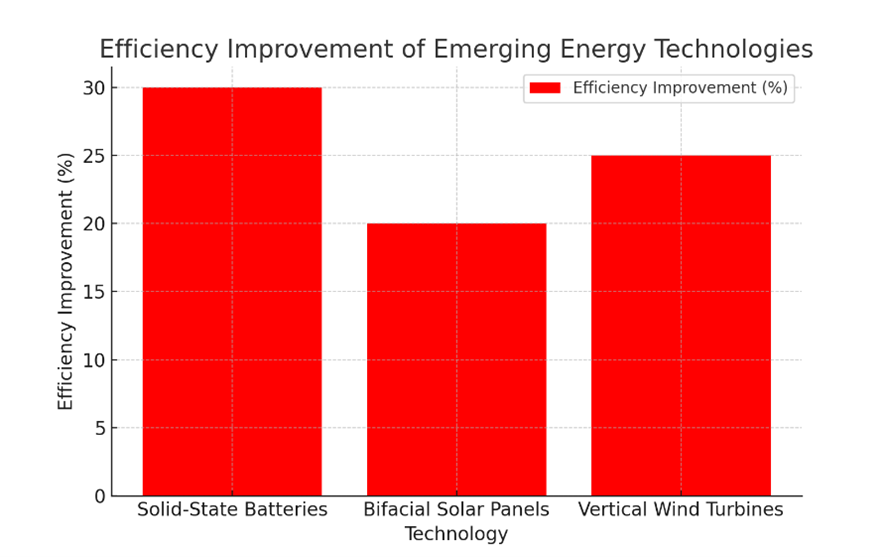Emerging Energy Storage Technologies
Green Technology ?? Comments 11/Feb/2025 TueEnergy storage technologies are evolving rapidly, addressing key challenges associated with the intermittent nature of renewable energy sources like solar and wind. These innovations allow for efficient energy storage, ensuring energy availability when production is low or demand is high. Below are some of the most promising developments in energy storage.
Details
-
Solid-State Batteries
o What They Are: Solid-state batteries replace the liquid or gel electrolyte found in traditional lithium-ion batteries with a solid electrolyte.
o Advantages:
-
Higher energy density, enabling longer-lasting storage in smaller, lighter designs.
-
Improved safety due to reduced risk of overheating or combustion compared to lithium-ion batteries.
-
Faster charging times and longer lifespan, making them ideal for renewable energy storage and electric vehicles.
o Applications:
-
Used in emerging electric vehicle (EV) designs, consumer electronics, and residential energy storage systems.
-
Expected to revolutionize home and grid-scale energy storage in the coming years.
-
-
Home Energy Storage Solutions
o Tesla Powerwall:
-
One of the most widely recognized home energy storage systems, the Tesla Powerwall stores excess energy from solar panels for later use.
-
Key Features:
-
Stores up to 13.5 kWh of energy per unit, enough to power essential appliances during the night or in an outage.
-
Includes an integrated inverter, enabling seamless connection with solar systems.
-
Can be stacked to increase storage capacity, allowing flexibility for homes with higher energy needs.
-
Benefits:
-
Reduces reliance on the grid and allows homeowners to take advantage of time-of-use (TOU) pricing by storing energy during off-peak hours for use during peak times.
-
Provides backup power during outages, increasing energy resilience.
o Other Solutions:
-
Enphase IQ Batteries: Offers modular energy storage systems that integrate with Enphase microinverters and solar panels.
-
LG Chem RESU: A compact, scalable battery system designed for residential use, compatible with various inverters and solar systems.
-
-
Flow Batteries
o What They Are: Flow batteries use liquid electrolytes stored in external tanks, allowing for scalable energy storage capacity.
o Advantages:
-
Longer lifespan with minimal degradation, ideal for long-term storage.
-
Scalability makes them suitable for large-scale applications, such as microgrids or commercial facilities.
o Applications:
- Currently used in industrial and grid-scale storage systems, with potential for future residential applications.
-
-
Thermal Energy Storage
o What It Is: This technology stores energy in the form of heat or cold, which can later be used to generate electricity or provide climate control.
o Examples:
-
Ice storage systems that produce and store ice during off-peak hours to cool buildings during the day.
-
Molten salt storage used in concentrated solar power (CSP) plants to store heat for electricity generation at night.
-
Hydrogen Energy Storage
o What It Is: Hydrogen energy storage involves converting excess electricity into hydrogen via electrolysis, which can later be used in fuel cells to generate power.
o Advantages:
-
High energy density and long-duration storage.
-
Versatility for use in transportation, heating, and electricity generation.
o Applications:
- Hydrogen systems are gaining traction in grid-scale storage and renewable energy integration.
-
Practical Example
Installing a Home Battery System for Solar Energy Storage
• Scenario: A household with solar panels wants to maximize energy savings and ensure backup power during outages.
• Solution: They install a Tesla Powerwall to store excess solar energy generated during the day for use at night or during grid disruptions.
• Steps Taken:
-
The homeowner connects the Powerwall to their existing solar system, enabling automatic energy storage.
-
During the day, excess solar energy charges the battery while powering the home.
-
At night, the battery supplies energy, reducing reliance on grid electricity and eliminating peak-hour charges.
-
The system provides seamless backup power during an outage, ensuring critical appliances remain operational.
• Results:
o The household reduces electricity bills by 30% annually by using stored energy instead of grid power during peak times.
o The Powerwall provides up to 24 hours of backup power during outages, increasing energy resilience.
Key Benefits of Emerging Energy Storage Technologies
-
Renewable Energy Optimization: Energy storage allows households and businesses to store excess energy from solar and wind systems, making renewable energy more reliable and accessible.
-
Grid Resilience: Advanced storage solutions, like batteries and thermal systems, stabilize the grid by storing energy during periods of low demand and supplying it during peak demand.
-
Energy Independence: Homeowners with energy storage systems can reduce or eliminate reliance on the grid, ensuring power availability during outages and extreme weather events.
-
Cost Savings: By storing energy during off-peak hours and using it during peak times, users can reduce electricity bills and take advantage of time-of-use pricing.
-
Scalability: Technologies like flow batteries and modular home systems can be expanded to meet the growing energy needs of households, businesses, and communities.
-
Environmental Impact: Energy storage reduces waste from renewable energy sources and decreases reliance on fossil fuel-based grid power, lowering greenhouse gas emissions.
By adopting advanced energy storage technologies like solid-state batteries and home solutions such as Tesla Powerwall, households and businesses can maximize the benefits of renewable energy, enhance resilience, and contribute to a more sustainable energy future.

Tags: energy technology